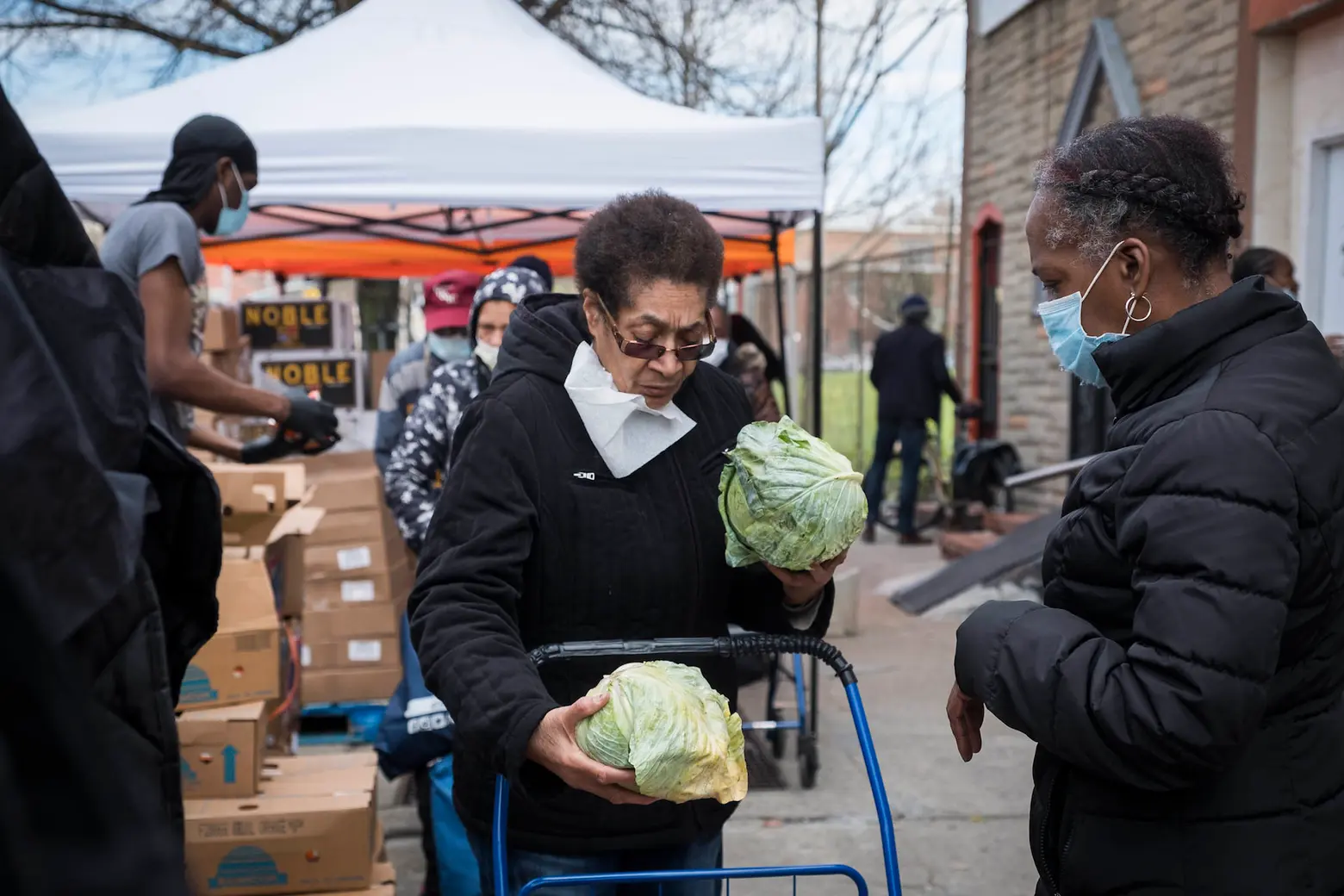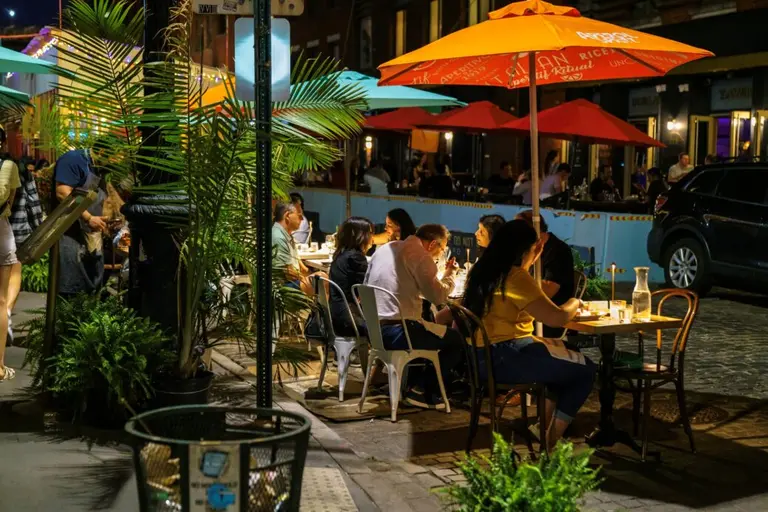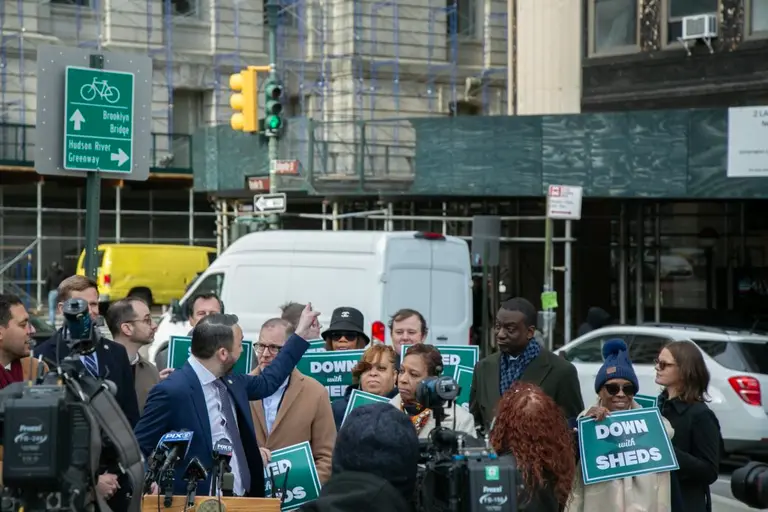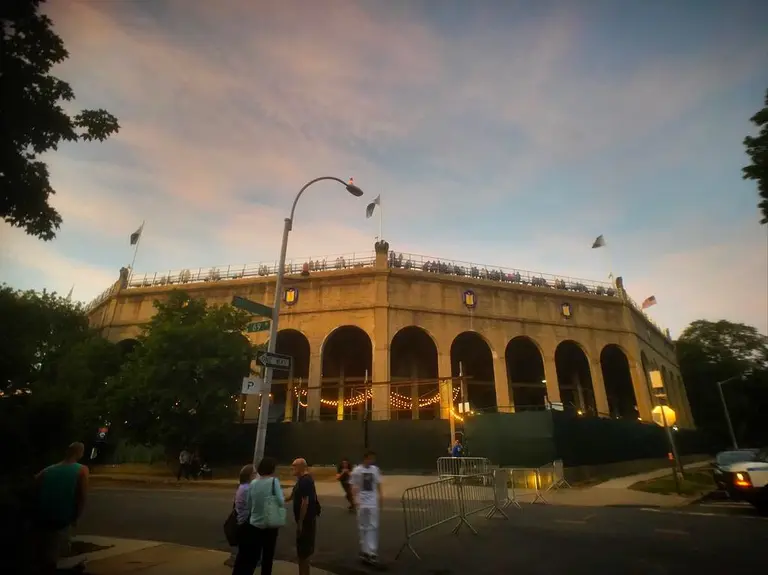A guide to food pantries and meal assistance in NYC

The Campaign Against Hunger food pantry in Brooklyn. Photo Credit: Ed Reed/Mayoral Photography Office on Flickr
Before the coronavirus pandemic, 1.2 million residents in New York City faced food insecurity. Now, with hundreds of thousands out of work, the number of hungry New Yorkers could double. A Siena College poll released last month found 49 percent of New York City residents were concerned about being able to afford food during the crisis. While city and state policies have been introduced to get food to residents, local community groups, nonprofits, and senior centers have also stepped up in this time of crisis to provide free food to those in need. Ahead, learn where to find free food, how to get meals delivered, and how to apply to food assistance programs, as well as the many NYC organizations currently in need of volunteers and donations.
Policies in place
Mayor Bill de Blasio released last month a $170 million plan to feed New Yorkers by boosting the existing food delivery systems run by the city and securing the food supply. The plan includes $25 million for the city’s 800 food pantries, which contains churches, food banks, and other community organizations. “Whoever you are, wherever you are, if you need food, we’re here for you, and there should be no shame,” de Blasio said.
Gov. Andrew Cuomo in April launched the $25 million Nourish New York initiative that purchases food and products from state farms and donates them to food banks and pantries. As of last week, the program purchased food from more than 2,100 farms to give to more than 50 food banks.
Where to go for free food assistance
The pandemic has put tremendous strain on the city’s food banks and pantries, as demand for food grows and the volunteer-driven organizations lack resources and staff. According to the Food Bank for New York City, more than 30 percent of emergency food programs–including soup kitchens and pantries–have halted operations. But there are still resources available for those who can’t afford to buy groceries.
The Hunter College New York City Good Policy Center has also put together an incredibly detailed guide of food resources by neighborhood. Find where to access free food in your community here.
Food banks and pantries
Hundreds of sites across the city are still open and serving free food to New Yorkers in need. Most have switched to grab-and-go bags of groceries to minimize any risk of exposure. Groups like the Food Bank for New York City and City Harvest have created interactive maps that highlight distribution locations. As hours and services are subject to change, it’s helpful to contact the food bank or pantry beforehand. Find an up-to-date list of soup kitchens and pantries, along with their address and phone number, organized by borough here.
New Yorkers can also download the app Plentiful, which was created in partnership with City Harvest, the United Way for New York City, and the New York City Food Assistance Collaborative. Not only does Plentiful help you locate food pantries by location and service times, but the free app also makes reservations at sites, avoiding long wait times. New Yorkers can also text “FOOD” to PANTRY (726-879).
Community groups
Local neighborhood groups have popped up across the city to help the most vulnerable New Yorkers find food, in addition to other services like education help, childcare, and job placement. Mutual Aid NYC has put together a crowd-sourced directory of resources by neighborhood, including on Long Island, along with contact information.
Since March, volunteer-run groups have collected donations to provide contactless deliveries of grocery and more for those in need. One Mutual Aid organization, Bed-StuyStrong, said it has provided an estimated 40,000 meals for 2,000 people to date, with a majority of the deliveries for elderly, immunocompromised, and disabled New Yorkers.
The Crown Heights Mutual Aid said it completed more than 1,200 grocery deliveries to those in need in the neighborhood just last week. The group also organized a pop-up fridge with free food outside of 1144 Bergen Street, on the corner of Bergen Street and New York Avenue.
Organizations serving homebound seniors
Citymeals on Wheels continues to serve the city’s vulnerable seniors during the pandemic. Since the state’s pause order, Citymeals has delivered more than 275,000 freshly-prepared weekend meals to homebound elderly. And the organization’s 3,300+ volunteers have helped deliver 450,000 shelf-stable emergency meals to seniors across the city to date. Find out if you are eligible for free meals from Citymeals here.
Since the height of the HIV/AIDS epidemic, God’s Love We Deliver has cooked and delivered healthy and medically-tailored meals to New Yorkers who have severe illnesses. While its mission remains unchanged during COVID-19, the organization is now serving even more people, adding 1,000 new clients. Since the start of the pandemic, God’s Love has home-delivered more than 50,000 meals to vulnerable seniors each week. For those in need of meals, eligible seniors should apply here.
Henry Street Settlement and Encore Community Services are providing free meals to homebound seniors in Manhattan. Henry Street Settlement delivers about 1,000 fresh meals every weekday to residents of Manhattan Community Board’s 1, 2, 3, 5, or 6. Encore will deliver hot and frozen meals to seniors who live on the West side of Manhattan, from 14th Street to 110th Street, from River Avenue to 5th Avenue.
Current clients of the city’s Department for the Aging meal delivery program can continue to receive food. The city is also providing food delivery assistance to households without grocery help and to those unable to afford meal delivery service. Eligible New Yorkers can apply here; call 3-1-1 for help.
Meal hubs at NYC Schools
All New Yorkers are eligible for free food at over 400 “meal hubs” at schools across the city. The grab-and-go meals are available Monday through Friday from 7:30 a.m. to 1:30 p.m. for children and families and from 11:30 a.m. to 1:30 p.m. for adults. Multiple meals can be picked up at once and no ID or documentation is required to receive food. Kosher and Halal meal options are available. Find a meal hub location near you.
Food assistance programs
If you’re struggling to pay for groceries, consider enrolling in food assistance programs, including the Supplemental Nutrition Assistance Programs (SNAP) and Women, Infants, and Children (WIC), which are state benefits set aside for pregnant women, mothers, and young children. Apply for SNAP here and WIC and other assistance programs here.
How to help
Contribute to food banks
Food banks and pantries are fighting to stay afloat. You can help these organizations meet increased demand and provide meals for your neighbors by giving a donation. Major groups open and accepting donations include the Food Bank for New York City, City Harvest, Holy Apostles Soup Kitchen, St. Joe’s Soup Kitchen, Project Hospitality, The Campaign Against Hunger, and more.
A new app called Beam lets you donate part of purchases made at New York-based eateries to nonprofit organizations, including local food pantries. Partners include Dos Toros Taqueria, Dig Inn, & pizza, and Mighty Quinn. New users who sign up using the code “HELP” will help Beam donate one meal to those in need.
Volunteer
If you can’t afford to donate, many organizations are in need of volunteers to run errands and deliver groceries to those in need. Find a local mutual aid organization near you and ways to contact them here.
Invisible Hands, which in March assembled 7,000 volunteers in its first two weeks, connects young, able-bodied volunteers with the elderly or immunocompromised. Those in need can request a delivery of groceries, prescriptions, and other supplies at a subsidized price. Reach out here to inquire about volunteering with Invisible Hands.
Discover volunteer opportunities at the aforementioned food banks, as well as at God’s Love We Deliver, Citymeals on Wheels, the Bowery Mission, Neighbors Together, and many others. Other ways to help can be found at In It Together, a group that helps place volunteers with dozens of organizations in the city.
RELATED:



























